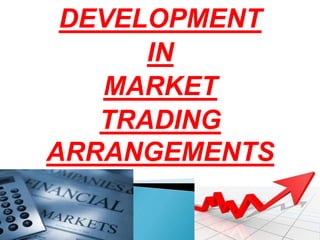Secuties market
- 1. Made By- AKSHAY SETHI SIDDHARTH SINHA SHIKHAR SAXENA SHASHANK MAIR
- 3. A stock exchange has certain listed securities and permitted securities which are traded on it. Members of the exchange alone are entitled to the trading privileges. Investors interested in buying or selling securities should place their orders with the members (also called brokers) of the exchange. There are two ways of organizing the trading activity: a) The open-outcry system b) The screen-based system
- 4. Under the open outcry system, traders shout and resort to signals on the trading floor of the exchange which consists of several ‘national’ trading posts for different securities. A member wishing to buy or sell certain security reaches the trading post where the security is traded.
- 5. In the screen-based system, the trading ring is replaced by the computer screen and distant participants can trade with each other through the computer network. A large number of participants, geographically separated, can trade simultaneously at high speeds.
- 6. Group of specific rules, or parameters, that determine entry and exit points for a given equity. Primary aim of a trading system- manage risk and increase profitability in any market environment. Prevailing in stock exchanges for many years. Types of Trading System- a)Floor Trading b)Screen Based Training - Quote Driven System - Order Driven System
- 7. Buyers and sellers transact business face to face. An investor desirous of buying a security gets in touch with broker and places the buy order along with the money for buying security. Similarly an investor intending to sell a security gets in touch with the broker, places the sell order and hands him over the share certificate to be sold. After the completion of the transaction, the buyer receives the share certificate and the seller would receive the cash from their respective brokers.
- 8. Fully automated mode of trading (online and offline). Trading ring is replaced by the computer screen and distant participants can trade with each other through the computer network. Brokers can install trading terminals at any place in the country. Large number of participants, geographically separated from each other, can trade simultaneously from their respective locations.
- 9. The market-maker, who is the dealer inputs two-way quotes into the system, that is, his bid price (buying price) and offer price (selling price). The market participants then place their orders based on the offer quotes.
- 10. Clients place their buy and sell order. These are then fed into the system. Buy and sell orders are automatically matched with the system according to predetermined rules.
- 11. Reforming Government Securities Markets in India – A pre-requisite for developing active derivatives markets on interest rates. STUDY BY Prof. Suresh Sundaresan, Chase Manhattan Bank Professor of Economics and Finance, Columbia University
- 12. 1. Government Debt Securities are “public goods”:- The presence of an actively traded “yield curve” in the Government Securities Markets provides a “price discovery” function about the risk-free cost of borrowing at different maturity sectors. The Government is in a unique position to supply “long-term risk-free” debt unlike any other private market participant: this is due to the fact that, in any country, Government alone has the ability to issue the local currency bond that is free from explicit default risk.
- 13. Auctions, Benchmarks, and Vintages Broadening Institutional Ownership Establishing a Retail Investor Base Ability to finance long and short positions













